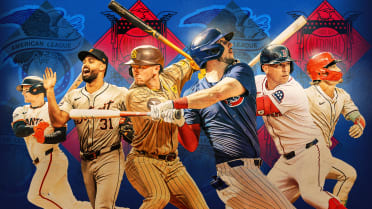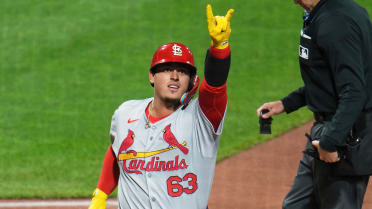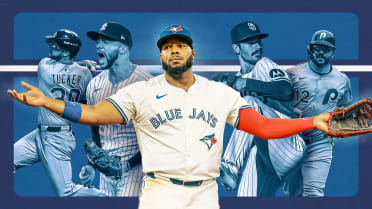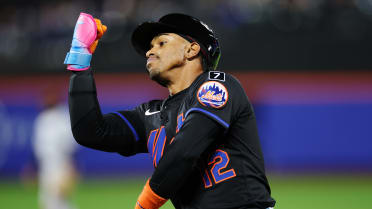From a fantasy standpoint, the Marlins' outfield has been surprisingly good.
Well, it's not that surprising. It's the only outfield with a Giancarlo Stanton, which would be enough to elevate any outfield out of the cellars. It has a Christian Yelich, too, who hits the ball hard but had been somewhat of a fantasy disappointment, having failed thus far to live up to any kind of power potential he once had.
Still, the Marlins are the game's second-best offensive outfield, per wRC+ (weighted runs created plus). That's kind of surprising. I mean, we knew the Pittsburgh Pirates' outfield, which currently ranks first, would be good. And we probably thought the Chicago Cubs' outfield, with all its talent and depth, would generate solid offensive numbers, but it's only 10th.
While it's a feel-good story riding on the high of an impressive 2016 Marcell Ozuna, it doesn't look entirely sustainable. But it doesn't mean we can't dream, and there are some reasons to be optimistic about the already-established Stanton and Yelich as well as the still-young Ozuna.
It's incredible how consistent Ozuna has been in terms of plate discipline and batted-ball profile between this year and last:
Marcell Ozuna, 2015 vs. 2016
Look at that. His strikeout rate (K%), walk rate (BB%), hard-hit rate (Hard%), pull rate (Pull%), infield fly-ball rate (IFFB%) -- they're all almost identical. It's pretty remarkable. With that said, it makes one wonder how much Ozuna could improve by being the exact same guy who was 11 percent worse than league average on offense last year.
Fortunately, Ozuna is hitting more fly balls -- a nice development for a guy whose calling card is power. Hard-hit rates north of 30 percent pretty much consistently boast home run per fly ball ratios (HR/FB) better than 10 percent. The higher the hard-hit rate creeps, so, too, does the HR/FB, and Ozuna's current 15.8 percent HR/FB rate is right where it should be. It's not scientific -- there are equations for that -- but ballparking it based on historical results indicates that this isn't an unreasonable assumption.
It seems like Ozuna's power last year was unluckily suppressed. Too bad the batting average on balls in play (BABIP) is unsustainable. At .378, it's barely achievable for the most prolific bat-control artists, let alone the free-swinging, powerful Ozuna. He hits the ball well to all fields and has decent speed, making an above average achievable, but something to this degree is unreasonable.
Learn all about advanced stats
So, maybe Ozuna isn't the 132 wRC+ guy he currently is. But he should be better than the 89 wRC+ guy he was last year with the 25-homer power he flashed in 2014. That Ozuna produced almost a 4.0 WAR (wins above replacement) that year and was 15 percent better than the league with the bat.
Yelich's batted-ball skills are something else, but his lack of fly balls hurt him for fantasy purposes.
Incredibly, Yelich is only 24, and that leaves him plenty of room for growth. Like clockwork, Yelich is striking out less than ever before and walking way, way more than ever before. It's his best 37-game rolling-walk rate ever, and he's holding onto his strikeout gains from the end of last season. In fact, he's walking almost as often as he's striking out -- something only a talented few hitters accomplish annually. Even with a career-worst BABIP (not by much, but still), Yelich is posting a career-best on-base percentage (OBP) by a full 50 points.
Meanwhile, Yelich is actually hitting more fly balls! Well, barely. Bordering on not really at all. His career rate is 16.3 percent; right now, it's 18.3 percent. If the season ended today, though, it would be the first time in his career he registered a ground-ball rate south of 60 percent. Sometimes, it's the little things that matter.
Like Ozuna, elements of Yelich's game are unsustainable. Right now, it's the HR/FB. It should probably be about half of what it is. But the OBP gains make Yelich at least a marginally better play in terms of run-scoring opportunities than he was prior to the season, and he's running just enough to stay relevant in stolen bases, too. Barring injury, 2016 should be the first time Yelich notches double-digit home runs (barely) and steals (probably also barely).
It'll always be the slightest bit disconcerting that Stanton strikes out almost 30 percent of the time. It's unfortunate we have yet to see that rate converge toward his (slightly) lower 2013-14 rates rather than stabilize at his 2015 peak. But given that, outside a blip early in the '11 season, Stanton has consistently been an above-average hitter, it's not really a legitimate concern.
Stanton's hard-hit rate is dragging a bit this season, but his truncated 2015 season is certainly the outlier here. Still, omit '15 and his current 36.9 percent rate would represent a career worst. Where there's cause for concern, though, there's equal reason to be excited: Stanton has maintained his career-best fly-ball rate from last year.
Maybe Stanton is hitting fewer balls hard, but in the grand scheme of things, it's only a few balls in play here and there. Moreover, the extra fly balls should at least offset any damage the contact issues might do to his isolated power (ISO). Worst-case scenario, the changes to his batted-ball profile produce a wash in regard to changes in outcomes. Best-case scenario, the contact quality improves and he sustains the increased batted-ball loft, manifesting in a version of Stanton that's difficult to comprehend.
But none of this will really change your mind about Stanton. He's an elite slugger.
All together, the three of them contribute to Major League Baseball's eighth-best offense by wOBA. Who knew!
A version of this article also appeared at FanGraphs.com.
Alex Chamberlain is a contributor to MLB.com.



